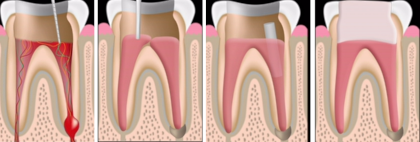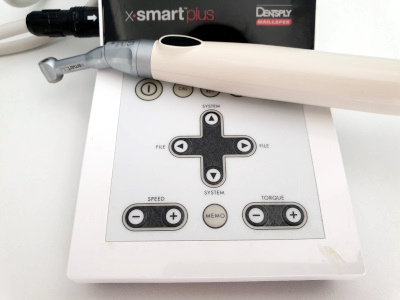What is root canal treatment or endodontics?
Root Canal Treatment process involves the removal of the pulp tissues—a key component of the tooth.
Endodontics, known as root canal treatment (devitalisation), is a field of dentistry dedicated to the cleaning of the internal part of the tooth. The term devitalisation is not applicable to most cases since the tooth is no longer ‘alive’ (vital). In these cases, endodontics does not implicate a true devitalisation.

In some cases, if the tooth chamber is infected by a cavity or has experienced an impact, the only way to treat the tooth is through endodontics or root canal treatment. When a cavity reaches the pulp, there are only two options: devitalise or extract.
A deep cavity, or one caused by other injuries, may cause an infection on the soft tissues of the tooth. During endodontic treatment, the dentist removes damaged or infected tissue and replaces it with a special filling material, which will support the tooth structure.
Endodontic Treatment – Root Canal Treatment

Endodontics, or root canal treatment, consists of cleaning the root canal with a biocompatible material and completely sealing the tooth.
After treatment, the pain will disappear. Deficient root canal treatment may cause cysts, infections, and even lead to extractions.
Endodontics is performed with an endomotor.
In which cases is endodontic treatment recommended?
- If a cavity is close to the nerve of the tooth and the person feels pain;
- If there is a high sensitivity to cold or heat;
- For partially destroyed teeth that need a screw post (small metal or fibreglass screw) for restoration purposes;
- For previously restored teeth that become broken afterwards with a diagnosis that includes a fixed, ceramic crown over the tooth.
How is a root canal treatment carried out?
It usually takes various treatment sessions to be completed. These sessions will help to assess how the patient’s tooth is responding to the treatment.
Is it a painful procedure?
Nowadays, endodontic treatment is not a painful procedure. There are a few exceptions, such as adjacent severe infections or inflammations, which should be previously treated with adequate medication.
Symptoms indicating the need for endodontic treatment:
- Increased sensitivity to hot or cold foods;
- Intense pain when biting;
- Deep cavity;
- A wound that causes an abscess (infection) on the bone.
Endodontic Treatment Stages
- Cavity removal (if there is one) to prevent contamination of the tooth canal. Dental tissue will be removed until the dentist reaches the root of the tooth causing pain and sensitivity;
- The dental pulp is removed and cleaned using rotary files (needle-shaped hand instruments). Files have various sizes and widths, just like the root canals;
- After cleaning the root canals, an x-ray is taken with the inserted files to show the canal length;
- Debris within the canal is removed by flushing with an anti-bacterial solution, Dakin (sodium hypochlorite);
- Files will be used to enlarge the root canal to an ideal dimension and for filling with a sealing material that will replace the removed nerve.
- The root canal is then dried and a biocompatible rubber filling is placed down the inside of the tooth, which is known as gutta-percha.
After these procedures, the tooth is restored in order for it to regain its function.
Root canal treatment will eliminate the pain and sensitivity.
Vita Center Medical Reference- Reviewed by VitaCentre Dental Clinic Staff on September 11, 2022

